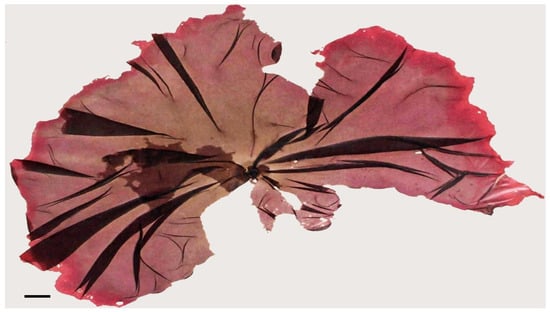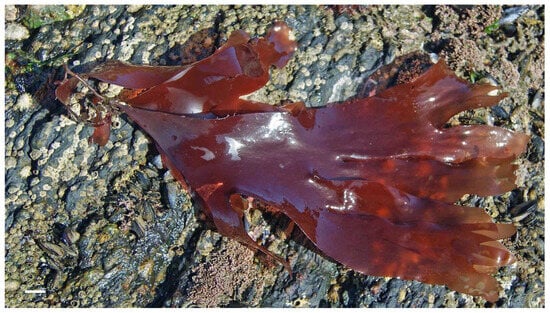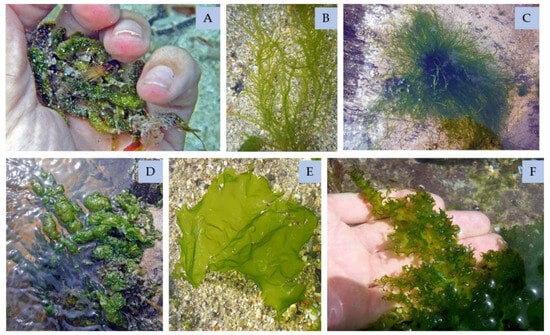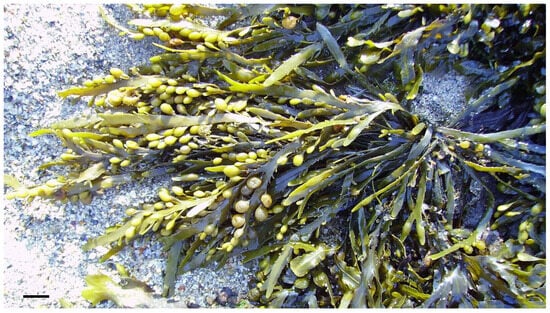2. Algae Food Products as Healthcare Solution
Algae demonstrate a potential for use in food products, such as bread, and their effects have been studied in several studies. The fact that they have a high content of minerals, proteins and amino acids can provide a higher nutritional value compared to conventional foods [
51]. On the other hand, there is increasing interest in nutraceutical preparations or food supplements as a health benefit, and macroalgae have great potential for this purpose due to their components with beneficial properties for health [
44].
2.1. Red Algae (Rhodophyta)
Porphyra/Pyropia (Rhodophyta) (
Figure 8), commonly known as Nori, is a red alga rich in protein, vitamins and minerals. It can be incorporated into gluten-free snacks or crackers, providing a source of essential nutrients for individuals with celiac disease while also offering a low-carbohydrate option for those managing diabetes or hyperglycemia [
98].
Figure 8. Porphyra umbilicalis. Scale bar = 1 cm.
Palmaria palmata (Rhodophyta) (
Figure 9), also known as Dulse, is a red algae species with antioxidant properties. Its powdered form can be included in gluten-free baking mixes, offering both nutritional benefits and contributing to the control of oxidative stress associated with diabetes [
22]. On the other hand, these red algae contain high levels of protein, between 9 and 25%, which in bread production has been shown to increase the nutritional profile of bread, which is accepted by consumers and has the potential to be developed as a bioactive product [
99].
Figure 9. Palmaria palmata. Scale bar = 1 cm.
Certain species of
Gelidium (Rhodophyta) can produce extracts rich in bioactive compounds, including antidiabetic agents. These extracts can be incorporated into functional beverages or health supplements targeting glycemic index control and diabetes management [
100].
Gracilaria species have been studied for their ability to reduce cholesterol levels. Incorporating
Gracilaria extracts into food products, such as gluten-free pasta or spreads, could help support individuals with celiac disease and diabetes while addressing cholesterol-related health concerns [
98,
101]. The genus
Gracilaria contains more than 300 species, and 160 are taxonomically accepted [
102]. It is of great economic importance as it has high biomass yields and the ability to produce agar. The species of the genus
Gracilaria produce weaker gels compared to other macroalgae genera; however, they are considered one of the most important sources of agar because they are fast-growing algae with a relatively low acquisition cost [
38,
102]. The addition of polysaccharides extracted from this type of algae has been shown to improve the nutritional, structural and shelf-life characteristics of foods. These species have low lipid contents and contain docosahexaenoic acid (DHA), a polyunsaturated fatty acid that is important in reducing the risk of cardiovascular diseases. In terms of amino acids, the most abundant are aspartic acid, alanine, glutamic acid and glutamine. Still, they are also a good source of soluble and insoluble dietary fibers and are, therefore, good alternatives to cereal-based fibers, which are used in Western countries [
54].
Allsopp et al. [
103] enriched bread with red algae and evaluated, in a study with humans, how its intake can influence markers of inflammation, lipid profile, thyroid function and antioxidant capacity.
2.2. Green Algae (Chlorophyta)
Green algae (
Figure 10) contain a variety of compounds with interesting biological activities. Species such as
Ulva clathrata,
Ulva compressa,
Ulva intestinalis,
Ulva linza and
Ulva flexuosa have been found to have a high capacity to eliminate radicals and can be used in pharmaceutical, cosmetic and food products [
69].
Figure 10. Examples of green algae (Chlorophyta): (
A)—
Dasycladus vermicularis; (
B)—
Ulva clathrata; (
C)—
Ulva compressa; (
D)—
Ulva intestinal; (
E)—
Ulva lactuca; (
F)—
Ulva linza [
69].
Flavonoids have been studied as antidiabetics, and extracts rich in this compound have been found to lower blood glucose and positively influence insulin release and resistance [
69].
Species belonging to the
Ulva and
Monostroma genera are of great interest as food due to their high protein content and polyunsaturated fatty acids [
36].
The use of green macroalgae in food or as a food supplement is still limited, and there are few studies in the literature. However, it should be noted that this type of algae also has great potential for food use due to the varied compounds it contains with bioactive and health-benefiting properties.
2.3. Brown Algae (Phaeophyceae)
Brown macroalgae show a high concentration of secondary metabolites, which have shown antidiabetic activity in vivo, and studies have seen a reduction in blood glucose, triglycerides and cholesterol levels, as well as hepatoprotective activity [
104,
105]. In studies with diabetic rats, a decrease in glucose levels, weight loss, and normalization of triglyceride and cholesterol levels were observed. A healing effect and regeneration of pancreatic cells were also observed in induced diabetic rats after administration with different concentrations of algae extracts [
106,
107].
Saccorhiza polyschides, initially classified as
Fucus polyschides, is considered an edible species and has, therefore, been studied for future nutraceutical applications [
108]. It is a brown alga (Phaeophyceae) belonging to the family Phyllariaceae and the class Phaeophyceae [
52,
109]. This alga is opportunistic and is most abundant in southern Europe, where it colonizes rocky substrates in the sublittoral [
52]. Its sporophyte is pale dark brown, with differentiated blades and a twisted base, and the attachment zone is composed of a rough “bulb”. It is a monocarpic and annual alga, but it is fast growing and can reach between 2 and 4 m in length in just 2 months [
52,
109]. It is a species that contains a high percentage of carbohydrates (45.6%) and protein (14.4%) as well as low levels of lipids (1.1%), and it has a concentration of minerals higher than that found in terrestrial plants. Due to its ability to adapt to environmental changes, such as salinity and temperature, it contains bioactive compounds synthesized in the presence of these types of changes [
52].
Różyło et al. [
52] evaluated the influence of adding brown macroalgae on the properties of gluten-free bread, namely, the physical and sensory properties and the antioxidant capacity. They obtained promising results in the production of this type of bread.
Studies in which edible Wakame seaweed (
U. pinnatifida) was added to pasta in different percentages found that it was accepted and had a slight taste of seaweed but was similar to the control sample. It was also found that the addition of the algae improved the quality of the pasta, as there was an interaction between the starch and the protein matrix [
110].
Beyond enhancing nutritional profiles,
A. nodosum and
F. vesiculosus offer a multifaceted approach to managing celiac disease and diabetes. Their bioactive compounds, such as sulfated polysaccharides, have demonstrated impressive antidiabetic effects, which include controlling glycemic index levels and mitigating the adverse effects of hyperglycemia. Moreover, these seaweed-derived compounds show promise in effectively regulating cholesterol levels, thereby reducing the risk of related health complications [
111].
2.4. The Use of Macroalgae in Gluten-Free Products
Studies addressing the effect of adding certain macroalgae to pasta or flour in bread production are still scarce. The first to conduct studies of this type were Medvedeva et al. [
112], who examined how the use of algae products can increase the nutritional value of bread. Mamat et al. [
113] verified the rheological properties of the bread paste and the quality of the same after adding seaweed to the flour. The beneficial effects that bioactive compounds, which are present in macroalgae, can present in different metabolic diseases are already known. The studies mentioned above mainly refer to wheat bread; however, studies where algae are added to gluten-free bread are even more scarce. Within products that do not contain gluten, gluten-free pasta has already been developed with the addition of algae to rice flour, resulting in a reduction in energy value, increased protein content as well as increased insoluble dietary fiber [
113]. Studies where there is the evaluation of different factors, such as the influence of macroalgae compounds in the production of gluten-free bread and possible diabetes treatments and the reduction of cholesterol through the properties of the bioactive compound, are not found in the literature, so there are strategies and factors worth studying so that foods or nutraceutical preparations based on macroalgae can be produced.
In light of the aforementioned challenges, certain macroalgae species, such as
Ascophyllum nodosum (
Figure 11),
Fucus vesiculosus (Phaeophyceae),
Cladophora spp. and
Ulva spp. (Chlorophyta) present a promising avenue for the development of specialized foods owing to their abundant reservoirs of proteins, amino acids and minerals. Studies, such as the ones conducted by Różyło et al. [
52] and by Menezes et al. in 2015 [
114], have indicated that incorporating these macroalgae species into food formulations can significantly elevate the nutritional value of various products. This becomes particularly crucial when addressing the limitations of gluten-free items in the bakery industry, as macroalgae-based additives may help compensate for the loss of gluten’s beneficial characteristics.
Figure 11. Ascophyllum nodosum. Scale bar = 1 cm.
By harnessing the inherent potential of
A. nodosum and
F. vesiculosus, it becomes feasible to develop innovative food products that can serve as therapeutic interventions or improvements for individuals with celiac disease and diabetes. Such products may not only cater to the dietary needs of these specific populations but also provide added health benefits through the incorporation of these specific macroalgae-derived bioactive nutraceuticals. As research in this field continues to unfold, with a focus on exploring other macroalgae species as well, it is anticipated that macroalgae-based foods will emerge as a valuable adjunct to conventional treatments, contributing to a more comprehensive and effective approach to managing these diseases and improving the overall well-being of affected individuals [
114].
It is important to note that the utilization of macroalgae species in food products requires careful research and formulation to ensure safety and effectiveness. Additionally, individuals with allergies or sensitivities to seafood should be cautious when consuming products containing seaweed or algae-derived ingredients [
9,
115].




